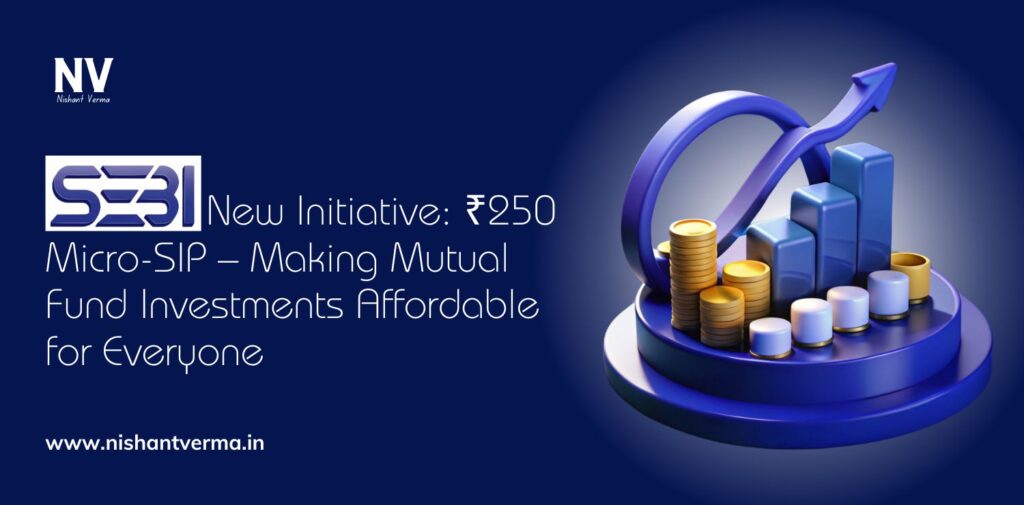In recent times, India has witnessed an increasing interest in mutual funds as a tool for wealth creation. The Securities and Exchange Board of India (SEBI), which regulates the financial markets in the country, has always been proactive in making investments accessible to more people. In a new initiative aimed at further democratizing investment, SEBI has announced its plans to work with mutual funds to develop a micro-SIP (Systematic Investment Plan) option, allowing investors to start investing with as little as ₹250 per month.
This announcement was made by SEBI Chairperson, Madhabi Puri Buch, and has sparked a lot of interest across financial circles. The introduction of a ₹250 micro-SIP plan is expected to make mutual fund investments more inclusive, particularly for those with limited financial means, such as low-income individuals, students, and small business owners. This article explains what this initiative means, how it works, and why it could be a game-changer for many Indians.
What is a SIP?
A Systematic Investment Plan (SIP) is a method of investing in mutual funds that allows investors to deposit small amounts of money at regular intervals, usually monthly or quarterly. Instead of investing a large lump sum at once, SIP allows for gradual investments, which is especially beneficial for individuals who may not have a significant amount of money to invest upfront.

Through SIPs, investors can buy units of a mutual fund over time. As the stock market fluctuates, the cost of these units may rise or fall. Over time, the investor can accumulate more units, with the benefit of averaging out the purchase price. This strategy is often referred to as rupee cost averaging, which helps minimize the impact of market volatility on investment.
SIPs have become very popular in India, particularly because they are simple to set up and provide a disciplined way of investing. Many people already invest through SIPs, with typical minimum amounts starting from ₹500 to ₹1,000 per month.
What is a Micro-SIP?
A micro-SIP is a smaller version of the regular SIP. With this new ₹250 micro-SIP option, individuals will be able to start investing in mutual funds with a much smaller amount of money. This opens up investment opportunities for people who might have found the existing minimum SIP amounts too high for their budgets.
In her recent announcement, SEBI Chairperson Madhabi Puri Buch mentioned that this new initiative aims to promote financial inclusion. By lowering the barrier for entry into mutual fund investments, SEBI hopes to encourage more Indians, particularly those in rural or lower-income urban areas, to take part in the country’s growing financial markets.
Why is SEBI Introducing the ₹250 Micro-SIP?
The primary reason SEBI is introducing the ₹250 micro-SIP is to make mutual fund investments more accessible to a broader segment of the population. India has a vast population, and a significant portion of it belongs to low- or middle-income households. For many of these individuals, the existing minimum SIP investment of ₹500 or ₹1,000 can be too high, especially when dealing with day-to-day expenses.

The micro-SIP is SEBI’s attempt to make sure that investing is not just for the wealthy or middle class but for everyone. It aligns with India’s broader goal of financial inclusion, which aims to ensure that every citizen has access to affordable financial services, including investment opportunities. It’s also a way to introduce the habit of regular savings and investments to more people, helping them grow their wealth over time, even if they can only contribute a small amount each month.
Moreover, the ₹250 micro-SIP initiative is expected to encourage first-time investors. By starting small, individuals can learn about mutual funds, gain confidence in investing, and gradually increase their contributions as their financial situation improves.
Benefits of the ₹250 Micro-SIP
Affordability: The most obvious advantage of the ₹250 micro-SIP is that it makes mutual fund investing affordable for more people. With just ₹250 a month, individuals can start investing, which lowers the entry barrier significantly.
Promotes Financial Discipline: SIPs promote the habit of regular investing. Even with a small monthly contribution, over time, the money invested can grow significantly, thanks to the power of compounding.
A Good Start for New Investors: The micro-SIP is ideal for those new to investing. It allows them to test the waters of the stock market and mutual funds without feeling like they’re risking too much. As their confidence grows, they can increase their investment amounts.

Rupee Cost Averaging: Even with a small monthly investment, investors will benefit from rupee cost averaging. This means that they will buy more units when the market is down and fewer units when the market is up, helping to reduce the overall cost of their investment in the long run.
Accessibility: SEBI’s initiative is aimed at improving access to the financial markets for people in rural areas and those from lower-income groups. For many of these individuals, ₹250 may be an amount they can afford to invest each month, thus allowing them to participate in the financial markets.
Flexibility: Investors can gradually increase their SIP amounts as their financial situation improves. The micro-SIP provides a good entry point for small investors, but they are not locked into that amount forever. They can adjust their contributions as needed.
Challenges and Concerns
While the introduction of the ₹250 micro-SIP is a promising step, there are a few challenges that SEBI and mutual fund companies will need to address to ensure its success.
Awareness and Education: Many people in rural and semi-urban areas may not be familiar with mutual funds or the concept of SIPs. SEBI and mutual fund houses will need to conduct awareness campaigns and financial literacy programs to educate potential investors about the benefits of mutual funds and how to use SIPs effectively.
Operational Costs: Mutual fund companies may face higher operational costs when managing many small accounts. The challenge will be to ensure that these costs do not eat into the returns of small investors.
Technology Access: While the penetration of smartphones and the internet is growing in India, there are still areas where people may not have easy access to digital tools required to set up and manage their investments. SEBI and mutual fund houses will need to ensure that investing is as simple as possible, including providing offline options for those without reliable internet access.
The Road Ahead
The ₹250 micro-SIP has the potential to revolutionize the way people in India invest. By making mutual fund investments more affordable and accessible, SEBI is paving the way for greater financial inclusion. However, to make this initiative truly successful, it will require a concerted effort from SEBI, mutual fund companies, and financial advisors to educate people and create awareness.
Over time, as more people begin to take advantage of the micro-SIP, we could see a significant shift in India’s investment landscape. With millions of small investors entering the market, the mutual fund industry will continue to grow, and more people will have the opportunity to build wealth over time, even if they start with just ₹250 a month.
In conclusion, SEBI’s micro-SIP initiative is a positive step toward making investing a reality for all Indians. With the right support and education, this scheme has the potential to change lives by encouraging savings and investment habits that will benefit individuals and the economy as a whole.




